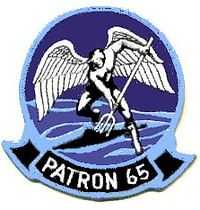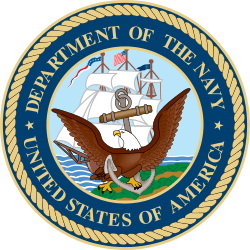VP-65

VP-65, nicknamed the Tridents, was a Patrol Squadron of the U.S. Navy Reserve. The squadron was established on 16 November 1970 at NAS Los Alamitos, California, and moved on 6 January 1971 to NAS Point Mugu. It was disestablished on 4 March 2006, after 35 years of service. Elements of the squadron made 22 major overseas deployments.[1][2]
Significant events
- 16 Nov 1970: VP-65 was established at NAS Los Alamitos, California, as a result of a major reorganization of the Naval Air Reserve that took place in 1970. The 12 Reserve squadrons formed were structured along the lines of regular Navy squadrons with nearly identical organization and manning levels. The reorganization concept was known as 12/2/1. There were 12 VP squadrons under two commands, Commander Fleet Air Reserve Wings Atlantic and Commander Fleet Air Reserve Wings Pacific, under the control of one central authority, Commander Naval Air Reserve. VP-65 was formed from the personnel and assets of seven smaller units already in existence at NAS Los Alamitos: VP-65L1-L3, VP-22L7, VP-19L4, VP-6L5, and VP-40L6. It came under the operational and administrative control of Fleet Air Reserve Wing, Pacific. The squadron’s first assigned aircraft was the SP-2H Neptune.
- 18–30 May 1971: VP-65 participated in Operation Condeca Aguila II with Guatemala to evaluate the joint forces’ ability to detect, identify and thwart seaborne aggressor efforts.
- 1–13 Jun 1972: VP-65 and VP-67 participated in exercises Halcon Vista VII and Condeca Aguila III with the Nicaraguan military forces.
- 21 Jul–5 Aug 1973: VP-65 deployed to NAS Barbers Point, Hawaii, for mining and antisubmarine warfare (ASW) exercises.
- Oct 1974: The squadron’s last SP-2H was officially transferred to the National Naval Aviation Museum at Pensacola, Florida.
- Jan 1975: The Tridents received the P-3A Orion as a replacement for the aging Neptune.
- Aug 1975: VP-65 deployed a detachment to NAS Agana, Guam, while operational training in the P-3 airframe continued for the remaining aircrews at NAS Point Mugu.
- Jun 1978: The Tridents deployed to NAS Agana, Guam, with detachments conducting maritime air patrol flights from NAS Cubi Point, Philippines, and Kadena AFB, Okinawa. One of the Cubi detachment aircraft, flown by PPC Lieutenant Commander F. Kluessendorf, experienced an engine failure during the takeoff roll on rotation. The propeller autofeather feature of the Orion aircraft prevented any instability during the takeoff, allowing the crew to safely return to Cubi for an uneventful landing.
- 1980: VP-65 deployed for its active duty training to NAS Agana, Guam and the Philippines, with detachments at Okinawa and Singapore searching for Vietnamese refugees.
- 25 Jun–29 Jul 1982: The Tridents deployed to NAS Cubi Point, Philippines, with operations conducted from Singapore, Okinawa, Guam and Thailand.
- 14 May–Jun 1984: VP-65 deployed to NAF Misawa, Japan. The squadron aircrews received real-world training flying missions covering Soviet Bloc submarines transiting the WestPac theater of operations.
- 31 May–30 Jun 1985: The Tridents deployed to Misawa, Japan. Upon return from deployment the squadron began the ground training necessary for the transition from the P-3A to the P-3B TAC/NAV/MOD airframe. The IRDS/HACLS modifications added infrared detection and Harpoon launch capability to the aircraft.
- Nov 1986: VP-65 received a letter of commendation from the Secretary of the Navy for the squadron’s role in Operation Close, a coordinated operation with the U. S. Coast Guard in support of their drug interdiction efforts.
- Jul–Aug 1989: VP-65 conducted active duty training at NAF Misawa, Japan. The Tridents participated with fleet squadrons VPs 19 and 46 in support of TF 72. Out of 1,015 hours flown during the deployment, over 52 hours were flown while in direct contact with Soviet Bloc submarines.
- Jun 1991: VP-65 deployed to NAF Kadena, Okinawa. Upon return from deployment the squadron
began the transition from the P-3B MOD airframe to the P-3C Orion. The baseline P-3C incorporated the AN/ASQ-114 computer system for navigation and sensor functions, the first of its kind in a maritime patrol aircraft. It had an AN/AQA-7 Jezebel acoustic processing system with DIFAR and quadruple the number of directional sonobuoys, with a high capacity computer and related displays. Completion of transition training was accomplished by June 1993.
- 13–27 Aug 1993: Two VP-65 aircrews deployed to NAS Adak, Alaska, the last operational detachment to fly from the air station before it went into caretaker status.
- Jan 1994: The Tridents began transition to the P-3C UII.5 Orion airframe. Update II.5 had improved electronics systems, new Integrated Acoustic Communication System (IACS), improved MAD, standardized wing pylons and improved wing fuel tank venting. Throughout the remainder of the year, detachments from VP-65 deployed to NAF Kadena, Japan; NAS North Island, California; and NAS Barbers Point, Hawaii, as part of the increased integration of reserves into active duty Navy operations and exercises under CTF-72.
- 1995: VP-65 detachments deployed at various times throughout the year to NAS North Island, Calif.; NAF Misawa, Japan; Biggs Army Airfield, El Paso, Texas; NAF Kadena, Okinawa; Utapao, Thailand; and Naval Station Roosevelt Roads, Puerto Rico.[1]
Aircraft Assignment
The squadron first received the following aircraft on the dates shown:[1]
- SP-2H Neptune – Nov 1970
- P-3A Orion – Jan 1975
- P-3B TAC/NAV MOD Orion – Dec 1985
- P-3C Orion – May 1991
- P-3C UII.5 Orion – Jan 1994
See also
- Maritime patrol aircraft
- List of Lockheed P-3 Orion variants
- Squadron (aviation)
- Naval aviation
- List of inactive United States Navy aircraft squadrons
- List of United States Navy aircraft squadrons
- History of the United States Navy
References
This article incorporates text from the public domain Dictionary of American Naval Aviation Squadrons.
- ↑ 1.0 1.1 1.2 Roberts, Michael D. (2000). Dictionary of American Naval Aviation Squadrons, Volume 2, Chapter 3, Section 11: Patrol Squadron Histories for 2nd VP-62 to VP-90 (PDF). Washington, D.C.: Naval Historical Center, Department of the Navy. pp. 332–334. Retrieved 2014-02-25.
External links
| ||||||||||||||||||||||||||||||||||||||||||||||||||||||||||||||||||||||||||||||
